The Catholic Sacrament of Anointing of the Sick used to be called Extreme Unction (last anointing), not because it was the last sacrament a Catholic received before checking out of this life but because it was the last anointing you received. Catholics are anointed with holy oils at Baptism and Confirmation, which usually occur fairly early in life, so the third anointing sacrament is received much later — hopefully.
The sacrament was also commonly called Last Rites, because before antibiotics and penicillin, more people died than recovered from disease and injury. In the same vein, Extreme Unction was the sign that nothing more could be done to prolong life, so the sick and injured were spiritually preparing for death. Even today, many elderly Catholics get a little shiver of dread when the Catholic hospital chaplain brings his purple stole and oils.
In reality, the Anointing of the Sick is to offer prayers for possible recovery, with the more important intention to give strength to the soul of the sick person. Often, when people are sick, they get discouraged, depressed, angry, annoyed, and afraid. The Church believes that the sacrament offers a special grace to calm the spirit. If physical recovery is God’s will, so be it. If not, then the person needs the grace, strength, and encouragement to bear the illness with dignity.
Administering the sacrament, the priest dips his finger in the oil stock, which often has cotton inside to absorb the oil and keep it from spilling and going bad. He dabs some on his thumb and then anoints the head, saying, “Through this holy anointing may the Lord in his love and mercy help you with the grace of the Holy Spirit.” Then, if possible, he anoints the palms of the person, saying, “May the Lord Who frees you from your sins, save you and raise you up.” If it’s an emergency, such as a patient in the trauma center, the priest can anoint any part of the body that’s available if the doctors and nurses are working on the head and hands of the injured person.
The Sacrament of Anointing of the Sick absolves all sins the person is sorry for but did not previously confess in the Sacrament of Penance. If the person can’t make a confession, the anointing compensates by forgiving sins she would’ve confessed were she able to do so. Because of this aspect of absolving sins, deacons can’t anoint, but priests and bishops can.
The Catholic notion of redemptive suffering, that is, uniting your own suffering with the crucified Jesus gives a person’s unavoidable suffering meaning and purpose. This notion is explicitly and implicitly expressed in the Sacrament of the Anointing of the Sick.
Because many sick and injured people recover nowadays, or at least go into remission, Catholics are able to receive the Sacrament of Anointing of the Sick as many times as needed. The elderly, people with many ailments, and those with a deadly or serious disease, chronic pain and suffering, or recurring illness, can and should be anointed often.

The Catholic Sacrament of Anointing of the Sick used to be called Extreme Unction (last anointing), not because it was the last sacrament a Catholic received before checking out of this life but because it was the last anointing you received. Catholics are anointed with holy oils at Baptism and Confirmation, which usually occur fairly early in life, so the third anointing sacrament is received much later — hopefully.